“Global AI-Driven Hyperautomation Market to reach a market value of USD 152.5 Billion by 2031 growing at a CAGR of 19.7%”
The Global AI-Driven Hyperautomation Market size is expected to reach $152.5 billion by 2031, rising at a market growth of 19.7% CAGR during the forecast period.
NLP’s ability to understand, interpret, and generate human language is crucial for automating text-heavy tasks like contract review, sentiment analysis, and monitoring social media. Thus, the natural language processing (NLP) segment acquired 17% revenue share in the market in 2023. The demand for natural language processing (NLP) is driven by the growing need for automation in customer interactions, document processing, and content analysis. Businesses increasingly adopt NLP-driven technologies like chatbots, voice assistants, and automated customer support to handle large customer queries and enhance user experiences.
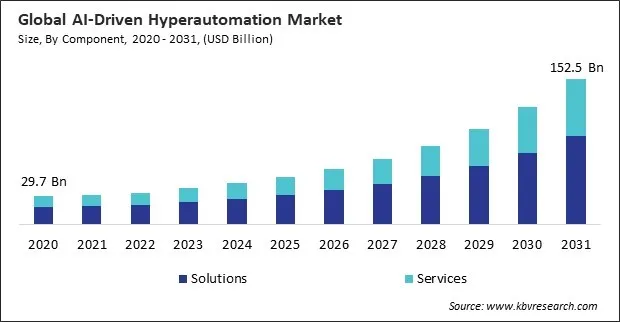
The major strategies followed by the market participants are Partnerships as the key developmental strategy to keep pace with the changing demands of end users. For instance, In March, 2024, NVIDIA Corporation and SAP expanded their partnership to enhance generative AI adoption across enterprise applications. By integrating NVIDIA's AI Foundry and NIM microservices, they aim to provide customers with scalable, domain-specific LLM capabilities within SAP's cloud solutions by the end of 2024. Additionally, in September, 2024, Tata Consultancy Services (TCS) has expanded its partnership with Google Cloud to launch two AI-powered cybersecurity solutions: TCS Managed Detection and Response and TCS Secure Cloud Foundation. These solutions enhance threat detection and response, bolstering cyber resilience across various industries.
Based on the Analysis presented in the KBV Cardinal matrix; Microsoft Corporation and Google LLC are the forerunners in the AI-Driven Hyperautomation. In April, 2024, Microsoft Corporation came into partnership with o9 Solutions, Inc. to enhance its Digital Brain platform by integrating Microsoft Azure OpenAI Service. This collaboration aims to boost AI-powered planning, streamline supply chain processes, and enable real-time decision-making while improving knowledge sharing across organizations for more efficient operations. Companies such as NVIDIA Corporation, Honeywell International, Inc. and Wipro Limited are some of the key innovators in AI-Driven Hyperautomation.
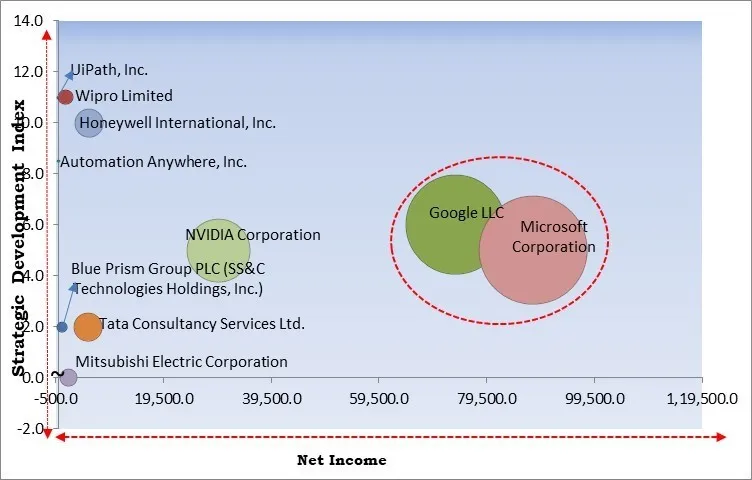
The flexibility of AI-driven systems is another significant factor behind their widespread adoption. Unlike static automation tools, AI and machine learning models can be trained to handle diverse tasks across different industries, from manufacturing predictive maintenance to retail customer service automation. This adaptability allows businesses to implement hyperautomation solutions in various processes, improving operational efficiency and reducing manual intervention. Hence, the combination of maturity, adaptability, and intelligence offered by AI and machine learning technologies makes hyperautomation solutions indispensable across industries.
Industries like logistics, smart cities, and energy management benefit significantly from integrating IoT and hyperautomation. IoT sensors track shipments and vehicle performance in logistics, while hyperautomation optimizes routes and schedules in real-time. Smart cities use IoT for infrastructure management, with hyperautomation enhancing traffic control, energy usage, and waste management. In energy management, IoT sensors in smart grids enable energy distribution automation based on real-time demand. Thus, the synergy between IoT and AI-driven hyperautomation has improved the market's growth potential.
Businesses may be reluctant to overhaul their legacy systems because of the risks involved in such transitions. The fear of potential data loss, downtime, or operational disruptions can create resistance among decision-makers, especially in industries that rely on continuous, uninterrupted services. For sectors like healthcare, finance, or manufacturing, where system failures can have critical consequences, the risks of integrating hyperautomation with legacy systems may outweigh the potential benefits, leading organizations to adopt a more cautious approach. Thus, the challenge of integrating hyperautomation technologies with legacy systems contributes to the slow adoption of these solutions across many industries.
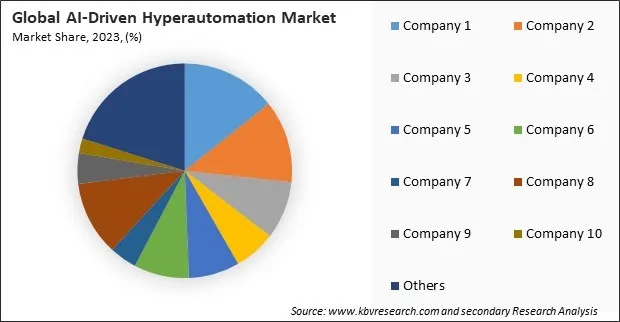
The leading players in the market are competing with diverse innovative offerings to remain competitive in the market. The above illustration shows the percentage of revenue shared by some of the leading companies in the market. The leading players of the market are adopting various strategies in order to cater demand coming from the different industries. The key developmental strategies in the market are Partnerships & Collaborations


Based on technology, the market is divided into robotic process automation (RPA), machine learning (ML), natural language processing (NLP), AI & cognitive computing, intelligent document processing (IDP), business process management (BPM), and low-code/no-code platforms. The machine learning (ML) segment procured 21% revenue share in the market in 2023. Businesses increasingly leverage ML to improve decision-making, optimize operations, and enhance customer experiences. The rise of big data and the need for real-time insights across industries such as finance, healthcare, and retail fuel the demand for ML-driven automation solutions.
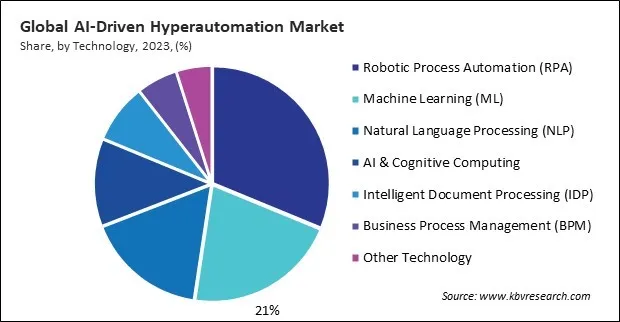
On the basis of function, the market is classified into process automation, data analytics & insights, customer service automation, IT operations automation (ITOps), business process management & optimization, document processing automation, and others. The process automation segment witnessed 32% revenue share in the market in 2023. Its dominance is due to its capacity to automate repetitive, rule-based duties in a variety of business functions, including finance, HR, and customer service. Organizations can reduce operational costs, enhance efficiency, and minimize human error by automating these processes.
By component, the market is bifurcated into solutions and services. The services segment witnessed 37% revenue share in the market in 2023. These services include consulting, system integration, maintenance, and support, helping organizations tailor automation strategies to their needs. With the complexity of hyperautomation solutions and the need for ongoing monitoring and optimization, businesses increasingly rely on service providers to help navigate the deployment process.
Based on enterprise size, the market is segmented into large enterprises and small & medium-sized enterprises (SMEs). The large enterprises segment acquired 61% revenue share in the market in 2023. These organizations have the financial resources, infrastructure, and operational complexities that benefit significantly from hyperautomation. Large enterprises increasingly adopt AI-driven solutions to enhance operational efficiency, streamline workflows, and reduce costs.
Free Valuable Insights: Global AI-Driven Hyperautomation Market size to reach USD 152.5 Billion by 2031
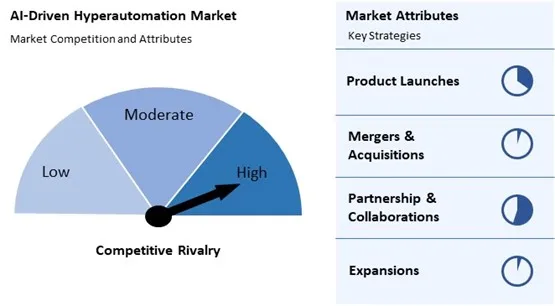
The AI-Driven Hyperautomation Market is marked by intense competition as organizations look to automate complex business processes using advanced AI and machine learning technologies. Providers are focused on delivering comprehensive solutions that integrate multiple tools to streamline operations, enhance productivity, and reduce human intervention. The growing demand for intelligent automation across various industries, such as finance, healthcare, and manufacturing, has intensified the race to offer scalable, flexible, and efficient hyperautomation platforms. Continuous innovation and the ability to adapt to diverse use cases are key to staying competitive.
Region-wise, the market is analyzed across North America, Europe, Asia Pacific, and LAMEA. The North America segment witnessed 36% revenue share in the market in 2023. The region's early adoption of AI and automation technologies, advanced technological infrastructure, and the presence of numerous innovative startups and tech titans can all be attributed to this. Additionally, the strong support from government initiatives and investments in digital transformation has further accelerated the adoption of AI-driven hyperautomation solutions in the region.
| Report Attribute | Details |
|---|---|
| Market size value in 2023 | USD 38 Billion |
| Market size forecast in 2031 | USD 152.5 Billion |
| Base Year | 2023 |
| Historical Period | 2020 to 2022 |
| Forecast Period | 2024 to 2031 |
| Revenue Growth Rate | CAGR of 19.7% from 2024 to 2031 |
| Number of Pages | 402 |
| Number of Tables | 584 |
| Report coverage | Market Trends, Revenue Estimation and Forecast, Segmentation Analysis, Regional and Country Breakdown, Competitive Landscape, Market Share Analysis, Porter’s 5 Forces Analysis, Company Profiling, Companies Strategic Developments, SWOT Analysis, Winning Imperatives |
| Segments covered | Component, Enterprise Size, Technology, Function, Region |
| Country scope |
|
| Companies Included | UiPath, Inc., Automation Anywhere, Inc., Blue Prism Group PLC (SS&C Technologies Holdings, Inc.), Wipro Limited, Honeywell International, Inc., Tata Consultancy Services Ltd., Mitsubishi Electric Corporation, Microsoft Corporation, Google LLC, NVIDIA Corporation |
By Component
By Enterprise Size
By Technology
By Function
By Geography
The Market size is projected to reach USD 152.5 billion by 2031.
Rapid Adoption of AI and Machine Learning are driving the Market in coming years, however, Substantially High Implementation Costs restraints the growth of the Market.
UiPath, Inc., Automation Anywhere, Inc., Blue Prism Group PLC (SS&C Technologies Holdings, Inc.), Wipro Limited, Honeywell International, Inc., Tata Consultancy Services Ltd., Mitsubishi Electric Corporation, Microsoft Corporation, Google LLC, NVIDIA Corporation
The expected CAGR of this Market is 19.7% from 2024 to 2031.
The Solutions segment is leading the Market by Component in 2023; thereby, achieving a market value of $92.4 billion by 2031.
The North America region dominated the Market by Region in 2023; thereby, achieving a market value of $53.0 billion by 2031.
Our team of dedicated experts can provide you with attractive expansion opportunities for your business.
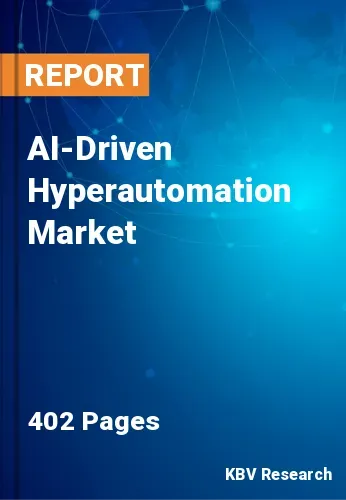
 Drivers
Drivers
 Restraints
Restraints
 Opportunities
Opportunities
 Challenges
Challenges
